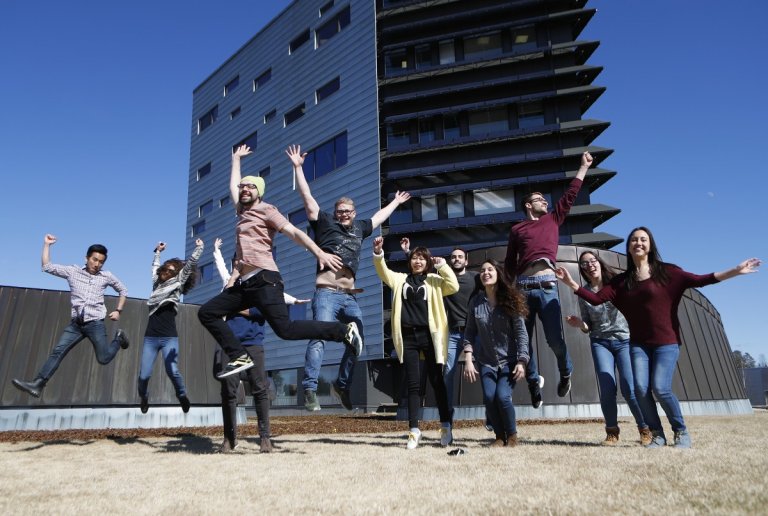
“Practicality is the best thing about the course. We can work as a group on an actual project, for a real company…The courses we have are based on what’s needed in the market. Sometimes the assignments even turn into companies themselves. This company I’m working for was founded as a course spin-off, and now has offices around the world.” – Niloufar Valinejad, Machine Learning & Data Science Student, Tampere University of Technology
Set within the Nordic region’s largest inland city, Tampere University of Technology (TUT) offers an expansive and cross-disciplinary education. Hosting a community of 8,300 undergraduate and postgraduate students – with 1,700 of these hailing from overseas – this institution proves a popular choice for the budding technical professional and digital entrepreneur.
As one of five specialised faculties within TUT, Tampere’s Faculty of Computing and Electrical Engineering has built its syllabus around the future of digital. With courses covering everything from communications technologies to software engineering, signal processing in intelligent machines to new majors in robotics and AI, students here experience the computing and engineering disciplines in their most detailed forms. And, as the first Finnish university to implement these new programmes, the faculty has recognised rising industry needs and added autonomous systems into its study structure.
“Robotics has reached a stage where the value that robots provide can be significantly amplified by enabling them to truly collaborate with humans,” says Otto Berkes, Executive Vice President and Chief Technology Officer at CA Technologies. “Developing the right models and algorithms for that collaboration, while paying careful attention to safety and cybersecurity will define the next phase of the robotics field. CA has the experience and our researchers have the deep technical expertise that can help inform this evolution.”

As soon as these ‘Cobot’ workflows are effectively executed and controlled, the potential for human-robot collaboration can be maximised. That is why CA Technologies has teamed up with TUT’s Faculty of Computing and Tieto, launching the Cobotics Collaboration Project to meet the demands of one of the fastest-growing developments in global robotics. The project explores exactly what it takes to construct safe, secure and effective Human-to-Robot workflows.
“Engaging in truly international collaboration with reputed companies, such as CA Technologies and Tieto in the field of cobotics, is very exciting for us [at] Tampere University of Technology,” says Professor Moncef Gabbouj of TUT. “It defines the essence of National Science Foundation Industry University Collaboration with international competence,” he adds. “The TEKES and NSF funded Center of Visual and Decision Informatics (CVDI) is proud to host such a project.”
But in terms of direct links with powerful industry players, TUT students have access to it all. Take SAAB as an example; a global powerhouse that provides security services and solutions, clocking up an annual revenue of SEK28 billion. Intent on expanding its Finnish presence to engage with future leaders of the sector, the organisation has introduced the SAAB Technology Centre (STC) in the heart of Tampere.
This state-of-the-art development hub proves incredibly valuable to TUT students. With unparalleled access to the specialised Electronic Warfare (EW) unit, there is a chance to get to grips with SAAB’s existing EW contracts for fighter aircraft, as well as the Electronic Support Measures/Electronic Intelligence Systems (ESM/ELINT) used for land applications.
Exciting things lie in store for TUT students with an interest in SAAB’s current activities. After a big push to recruit the top talent in the city throughout 2017, the headhunt is due to continue this year – and TUT’s ambitious Computing and Engineering students will be top of the pack.

“Finland is a high-tech country and an important partner for SAAB,” says Håkan Buskhe, company President and CEO. “The long-term goal is that STC in Tampere will be an integral part of SAAB’s product development and production.”
Yet SAAB is not the only influential company to recognise the city as a pool of opportunity, with Ponsse and Epec establishing a joint project development unit in Tampere. Dedicated to designing software and automation for mobile work machines, the ultimate aim of the unit is to ensure the continued availability of top experts in the field.
No one benefits from these high-end corporate connections more than the TUT students themselves. When Talita Carneiro was a seven-year-old girl making her fun on the streets of Brazil, she was assigned a creative school project and the focus was all about Finland. As a young child with no preconceived notion about this exciting new region, Talita began conducting research and instantly fell in love. Her passion for Finland continued to flourish along with her interest in tech, and when she discovered that tech-giant Nokia’s global HQ was located here, Talita knew that Finland was eventually where she would end up.
“I did my bachelor’s degree back home and came here for the first time as an exchange student in 2013,” she says. “I went back to Brazil, but soon returned to do my master’s thesis at TUT.
“The difference between studies in Brazil and Tampere is the hands-on mentality,” the former student adds. “In Brazil, we had a lot of theory, when here we have more lab classes. Knowing how to use the practical tools is essential in the working life.
“I really love Finland,” Talita concludes. “Even my dream of working for Nokia came true while studying at TUT and I couldn’t be happier.”
Follow TUT on Facebook, Twitter, YouTube and LinkedIn
Liked this? Then you’ll love these…
Computer science is all the rage with students across the Asia Pacific
5 European Computer Science Schools that will future-proof your career







